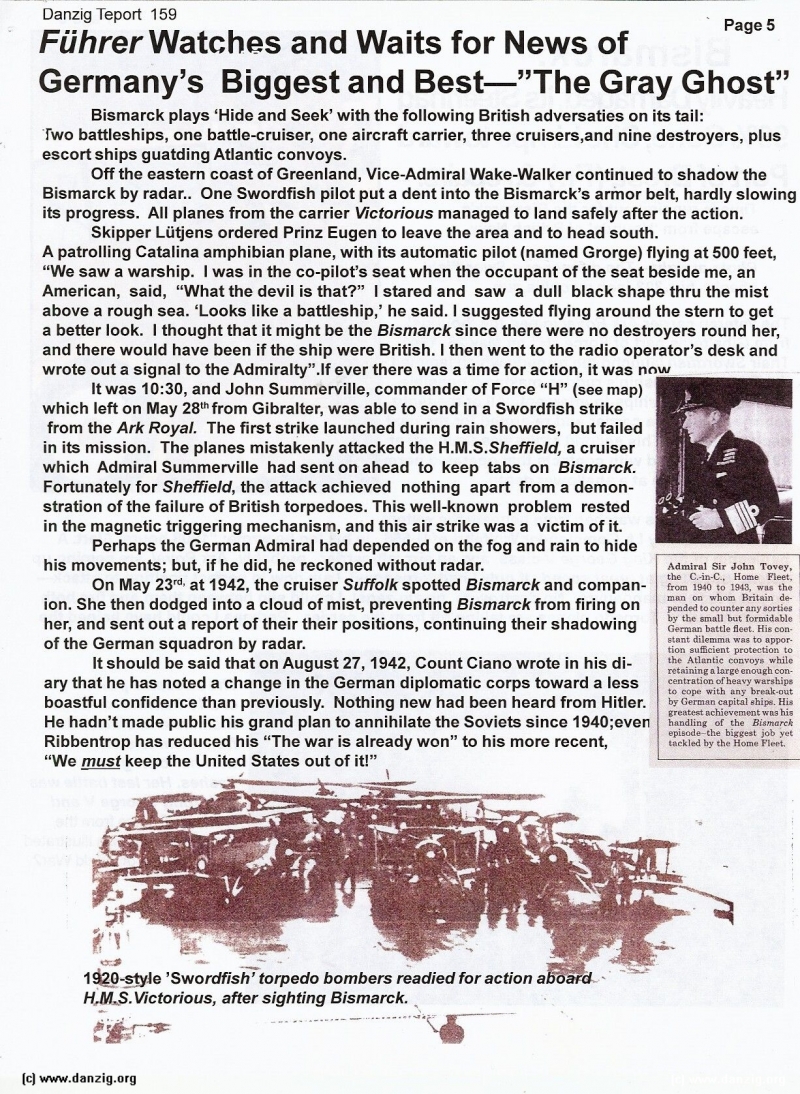
Fuhrer Watches and Waits for News of Germany’s Biggest and Best “The Gray Ghost”
Bismarck plays ‘Hide and Seek’ with the following British adversaties on its tail: Two battleships, one battle-cruiser, one aircraft carrier, three cruisers, and nine destroyers, plus escort ships guatding Atlantic convoys.
Off the eastern coast of Greenland, Vice-Admiral Wake-Walker continued to shadow the Bismarck by radar. One Swordfish pilot put a dent into the Bismarck’s armor belt, hardly slowing its progress. All planes from the carrier Victorious managed to land safely after the action.
Skipper Lütjens ordered Prinz Eugen to leave the area and to head south.
A patrolling Catalina amphibian plane, with its automatic pilot (named Grorge) flying at 500 feet, “We saw a warship. I was in the co-pilot’s seat when the occupant of the seat beside me, an American, said, “What the devil is that?” I stared and saw a dull black shape thru the mist above a rough sea. ‘Looks like a battleship,’ he said. I suggested flying around the stern to get a better look. I thought that it might be the Bismarck since there were no destroyers round her, and there would have been if the ship were British. I then went to the radio operator’s desk and wrote out a signal to the Admiralty”. lf ever there was a time for action, it was now.
It was 10:30, and John Summerville, commander of Force “H” (see map) which left on May 28th from Gibralter, was able to send in a Swordfish strike from the Ark Royal. The first strike launched during rain showers, but failed in its mission. The planes mistakenly attacked the H.M.S.Sheffield, a cruiser which Admiral Summerville had sent on ahead to keep tabs on Bismarck. Fortunately for Sheffield, the attack achieved nothing apart from a demonstration of the failure of British torpedoes. This well-known problem rested in the magnetic triggering mechanism, and this air strike was a victim of it.
Perhaps the German Admiral had depended on the fog and rain to hide his movements; but, if he did, he reckoned without radar.
On May 23rd, at 1942, the cruiser Suffolk spotted Bismarck and companion. She then dodged into a cloud of mist, preventing Bismarck from firing on her, and sent out a report of their their positions, continuing their shadowing of the German squadron by radar.
It should be said that on August 27, 1942, Count Ciano wrote in his diary that he has noted a change in the German diplomatic corps toward a less boastful confidence than previously. Nothing new had been heard from Hitler. He hadn’t made public his grand plan to annihilate the Soviets since 1940; even Ribbentrop has reduced his “The war is already won” to his more recent, “We must keep the United States out of it!”
Admiral Sir John Tovey, the C-in-C., Home Fleet, from 1940 to 1943, was the man on whom Britain depended to counter any sorties by the small but formidable German battle fleet. His constant dilemma was to apportion sufficient protection to the Atlantic convoys while retaining a large enough concentration of heavy warships to cope with any break-out by German capital ships. His greatest achievement was his handling of the Bismarck episode—the biggest job yet tackled by the Home Fleet.
1920-style ‘Swordfish’torpedo bombers readied for action aboard - HMS. Victorious, after sighting Bismarck.
Danzig Report Nr. 159 - 1st Quarter 2013, Page 5.
Hits: 3979
Added: 12/08/2015
Copyright: 2025 Danzig.org

